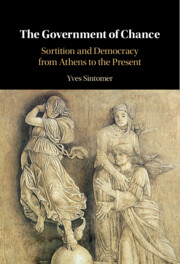Book contents
- The Government of Chance
- The Government of Chance
- Copyright page
- Dedication
- Contents
- Tables
- Acknowledgments
- Note on the Text
- Introduction
- 1 Democracy, Modern and Ancient
- 2 Sortition’s Second Birth in the Middle Ages and the Early Modern Period
- 3 The Disappearance of Sortition in Politics
- 4 The Return of sortition
- 5 Sortition and Politics in the Twenty-First Century
- References
- Index
2 - Sortition’s Second Birth in the Middle Ages and the Early Modern Period
Published online by Cambridge University Press: 18 February 2023
- The Government of Chance
- The Government of Chance
- Copyright page
- Dedication
- Contents
- Tables
- Acknowledgments
- Note on the Text
- Introduction
- 1 Democracy, Modern and Ancient
- 2 Sortition’s Second Birth in the Middle Ages and the Early Modern Period
- 3 The Disappearance of Sortition in Politics
- 4 The Return of sortition
- 5 Sortition and Politics in the Twenty-First Century
- References
- Index
Summary
Chapter Two analyzes the rebirth of sortition in the West during the Middle Ages and the Early Modern period. It explores the mutations of the medieval and Renaissance Italian republics, as well as the practices of sortition in Early Modern Spain, Switzerland, and other European countries. During these periods, sortition was widespread and took many different guises, though it was always combined with elections and cooption. It was above all a means to channel the competition for power and resources among groups, and especially among the elite. It was a key element of “distributive aristocracies” in different republican contexts, in which a relatively small subsections of elite citizens could develop self-government in the name of the common good and enjoy the privileges of administrating the polity. In the Italian Communes of the thirteenth century and for limited periods of time in Florence, republican self-government was extended to a larger circle of citizens. Practices of sortition in India are also described. Prior to modernity, although the scientific notion of representative sampling was still unknown, political sortition was linked to an empirical “taming of chance” and used as a rational instrument of government.
Keywords
- Type
- Chapter
- Information
- The Government of ChanceSortition and Democracy from Athens to the Present, pp. 66 - 124Publisher: Cambridge University PressPrint publication year: 2023



